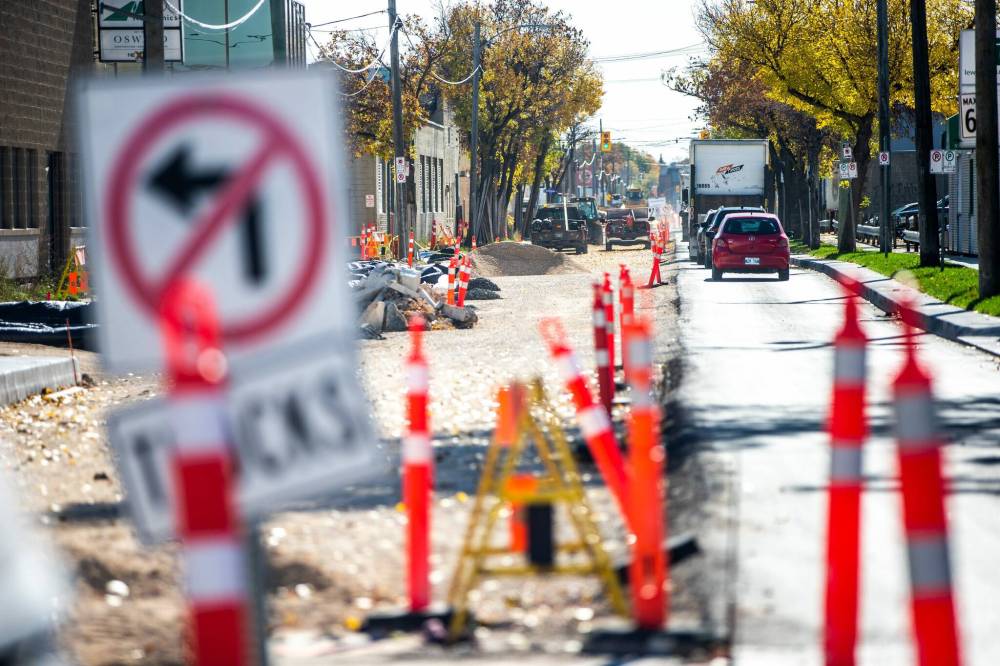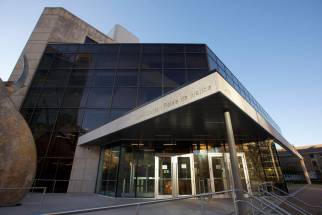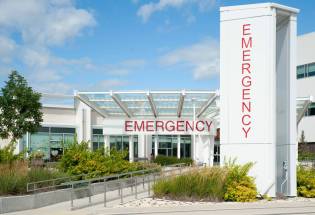Hitting the pavement Winnipeg’s next council at crossroads over infrastructure deficit
Read this article for free:
or
Already have an account? Log in here »
To continue reading, please subscribe:
Monthly Digital Subscription
$0 for the first 4 weeks*
- Enjoy unlimited reading on winnipegfreepress.com
- Read the E-Edition, our digital replica newspaper
- Access News Break, our award-winning app
- Play interactive puzzles
*No charge for 4 weeks then price increases to the regular rate of $19.00 plus GST every four weeks. Offer available to new and qualified returning subscribers only. Cancel any time.
Monthly Digital Subscription
$4.75/week*
- Enjoy unlimited reading on winnipegfreepress.com
- Read the E-Edition, our digital replica newspaper
- Access News Break, our award-winning app
- Play interactive puzzles
*Billed as $19 plus GST every four weeks. Cancel any time.
To continue reading, please subscribe:
Add Free Press access to your Brandon Sun subscription for only an additional
$1 for the first 4 weeks*
*Your next subscription payment will increase by $1.00 and you will be charged $16.99 plus GST for four weeks. After four weeks, your payment will increase to $23.99 plus GST every four weeks.
Read unlimited articles for free today:
or
Already have an account? Log in here »
Hey there, time traveller!
This article was published 07/10/2022 (1156 days ago), so information in it may no longer be current.
The City of Winnipeg plans to spend $873 million to reconstruct or renew 1,035 kilometre-lanes of streets over the next six years — about the distance to Churchill from Winnipeg.
It seems like a lot, but it only represents about 13 per cent of the city’s total road inventory. At that rate, it would take about 48 years to resurface or reconstruct all of Winnipeg’s streets and alleys. That doesn’t include new roads built in suburban areas.
The city has improved the overall condition of its roads in recent years, funded in large part by a two per cent annual property tax increase dedicated to street repair. However, experts say the level of investment in roads, sidewalks and active transportation routes still falls short of what’s needed. They say fixing the city’s crumbling infrastructure should be a top priority in this civic election campaign.
MIKE DEAL / WINNIPEG FREE PRESS FILES “At a high level, I would say that the city has done a relatively good job in terms of investing in its streets system, inadequate though it might be,” said Chris Lorenc, president of the Manitoba Heavy Construction Association.
“At a high level, I would say that the city has done a relatively good job in terms of investing in its streets system, inadequate though it might be,” said Chris Lorenc, president of the Manitoba Heavy Construction Association.
“I think that the inventory of regional streets is beginning to look a little bit better — but I think they have some real challenges on residential (roads).”
The city spends more than double what it did a decade ago on road maintenance. The results have been promising: the percentage of regional streets, such as Portage Avenue and Pembina Highway, assessed in “new/good” condition increased to 72.4 per cent in 2020 from 60.4 per cent in 2013.
Local roads in that category increased to 69.1 per cent from 58.6 per cent. The percentage of roads deemed in poor shape has declined during that period. New residential streets built in suburban areas — about 25 to 50 km-lanes of which are added to the city’s inventory each year — improve the overall ranking.
Overall, city hall is spending record amounts on infrastructure, including more money for bridges, sewer and water treatment plants and buildings.
However, most of the improvements came from upgrades to existing roads. From 2013 to 2020, 1,054 km-lanes of local and regional roads were reconstructed or renewed, about three times the 340 km-lanes of new streets transferred to the city from developers.
Overall, city hall is spending record amounts on infrastructure, including more money for bridges, sewer and water treatment plants and buildings. As a result, Winnipeg’s infrastructure deficit — the difference between what the city plans to spend over a 10-year period and what it believes it should spend — has declined to $6.9 billion (2018-27) from $9.9 billion (2009-18), both measured in 2018 dollars.
Of that, 58 per cent is to fix existing infrastructure and 42 per cent is for new projects, such as bus rapid transit or new city buildings. The estimated deficit was published in 2018 as part of the city’s state of the infrastructure report. It may have shrunk slightly since then, after higher-than-expected capital spending over the past four years. The report showed road maintenance has declined as a proportion of the city’s total infrastructure deficit. In 2009, it represented 47 per cent of the deficit; it fell to 28 per cent in 2018.
Still, Winnipeg’s infrastructure deficit is daunting. The need for more resources to improve transit, fix roads and bridges, and expand bike routes, is unquestionable. For some, major projects such as the widening of Kenaston Boulevard and the extension of Chief Peguis Trail, are vital to economic growth.
MIKAELA MACKENZIE / WINNIPEG FREE PRESS FILES Mayor Brian Bowman speaks at a joint funding announcement for the north end sewage treatment plant in August.
However, all of those projects cost money and there isn’t enough of it to go around.
The city has a long list of so-called unfunded infrastructure projects — those deemed a priority, but for which funding has not been allocated. Most experts agree the majority of those require financial support from senior levels of government.
The burning question in this civic election is whether the city should raise property taxes beyond current rates to kick-start some of those projects and to accelerate road repair. For the past several years, the city has increased property taxes by 2.33 per cent (two per cent for road repair and 0.33 per cent for bus rapid transit capital costs). Some say that’s not enough to keep up with growing demands.
Lorenc says the city should do an updated assessment of its infrastructure inventory, including an in-depth analysis of current road conditions, before proposing higher taxes. That assessment should be based on what it requires to grow its economy, which in turn would generate much-needed tax revenue for the city, he said.
“Growth is what we should all want to focus on to be able to deal with the challenges that we face: homelessness, crime, drugs and addiction.”–Chris Lorenc, president of the Manitoba Heavy Construction Association
“Growth is what we should all want to focus on to be able to deal with the challenges that we face: homelessness, crime, drugs and addiction,” said Lorenc. “Growing the economy is the enabler of everything.”
Winnipeg has among the lowest municipal property taxes in the country. While that has given the city bragging rights over the years, it has robbed city hall of much needed revenues, said Greg Mason, an economics professor at the University of Manitoba. Winnipeg is the economic engine of the province and it can no longer afford to take a “penny-pinching” approach to investing in vital infrastructure, he said.
“We need tax increases in the order of 10 per cent,” said Mason. “The infrastructure deficit has gotten so big that the numbers are overwhelming.”
Ideally, the city should work with the province to develop a taxation and capital spending plan for the greater Winnipeg region that would include nearby communities such as Steinbach, Selkirk and Stonewall, said Mason.
MIKAELA MACKENZIE / WINNIPEG FREE PRESS People and businesses from Steinbach, Selkirk and Stonewall benefit from Winnipeg’s infrastructure and should be part of a broader taxation strategy to pay for it, said Greg Mason, an economics professor at the University of Manitoba.
People and businesses from those areas benefit from Winnipeg’s infrastructure and should be part of a broader taxation strategy to pay for it, he said.
For now, the city has little choice but to significantly raise property tax rates to fund much-needed infrastructure, said Mason. To maintain affordability for lower-income Winnipeggers, the city could implement a progressive property tax, similar to how income taxes are charged, with higher mill rates for more expensive properties, he said.
The city should also implement a growth tax on properties in new developments, one that could pass the muster of the courts, said Mason. The city implemented a growth tax for new developments in 2017. However, it was struck down by the courts as unconstitutional because it wasn’t tied to related infrastructure costs.
“The property tax is a wealth tax,” said Mason. “That’s a fair tax because it’s financing the city’s infrastructure, it’s financing the quality of life in the city and land owners benefit from that because the quality of life drives population (and) population drives land values.”
“No new taxes until I determine specifically where the money is going and how it’s being spent.”–Kevin Klein, mayoral candidate
Not everyone agrees raising taxes to pay for infrastructure is the best option. At least two mayoral candidates, Kevin Klein and Jenny Motkaluk, say they are opposed to tax increases of any kind.
Klein, who has been a city councillor for the past four years, said before raising taxes, the city should figure out if it has a spending problem or a revenue problem.
“No new taxes until I determine specifically where the money is going and how it’s being spent,” he said during a mayoral forum Wednesday.
So far, the only mayoral candidate to propose a tax increase is Coun. Scott Gillingham. The former chairman of the finance committee pledged an annual increase of 3.5 per cent, arguing the city has no choice but to generate additional revenues to pay for needed infrastructure.
JOHN WOODS / WINNIPEG FREE PRESS FILES Scott Gillingham (from left), Kevin Klein and Shaun Loney have differing opinions on how the city should handle road maintanence.
He said he would also raise the frontage levy on properties by $1.50 per foot, money that is earmarked for street maintenance and water and sewer repairs. Under Gillingham’s plan, a 1.2 per cent tax hike would be added to the existing 2.33 per cent increase. All told, the measures would raise an additional $167 million over four years.
Two mayoral candidates, Shaun Loney and Rick Shone, have taken a different approach to road repair. They argue the city should fix the streets it has before building new ones.
Loney calls it the “fix it first” approach.
However, Mason said putting the brakes on new street construction, including in suburban neighbourhoods, would reduce new housing in Winnipeg and drive development outside the city, contributing to even greater urban sprawl. It’s unlikely developers would invest in new subdivisions if they couldn’t build streets.
Lorenc called the idea of putting a moratorium on new street construction in a growing city such as Winnipeg “ridiculous” and “counterproductive.”
“It would grind the city to a halt,” he said.
Several candidates have made pledges to improve the city’s infrastructure, but haven’t said how they would pay for it. Loney said he plans to release his fully costed plan on Oct. 10.
tom.brodbeck@freepress.mb.ca

Tom has been covering Manitoba politics since the early 1990s and joined the Winnipeg Free Press news team in 2019.
Our newsroom depends on a growing audience of readers to power our journalism. If you are not a paid reader, please consider becoming a subscriber.
Our newsroom depends on its audience of readers to power our journalism. Thank you for your support.












